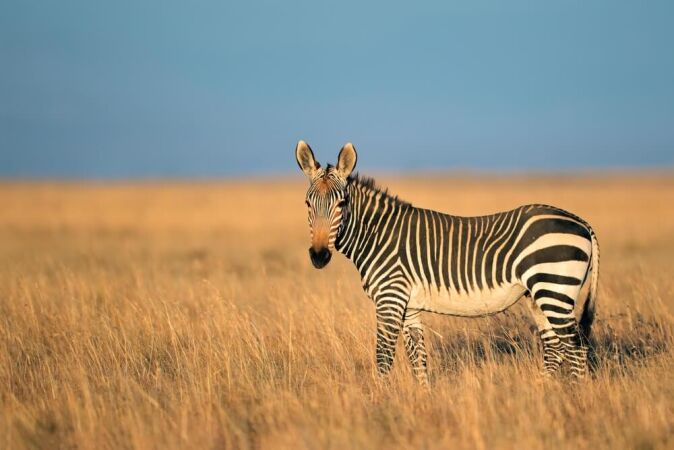

Grevy’s Zebra (Equus grevyi) is a coveted African plains game hunting trophy to target when safari hunting in Africa. It is endemic to Ethiopia and Kenya and listed with a status of “endangered” on the IUCN listing. Their population is declining rapidly, as they are poached for meat and their stunning skins. In some African regions, they are used for medicinal purposes. Additional factors for their decline include a shrinking habitat and disease.
This species of zebra prefers a dry, hot climate, and a semi-arid habitat with grasslands, but they must have access to a reliable water source. They are more active during the day and are often seen grazing alongside other African plains game animals, such as ostriches and wildebeest. Grevy’s zebras stay and move around in small adult groups. Their diet consists mainly of grass, but they also consume fruit, bark, and leaves.
Breeding occurs all year, with peaks in July to August, and October to November. After a 13-month gestation, one foal is born. What is amazing about this animal is that the young foal (and young is the operative word here!), can stand after only six minutes and can run in less than an hour. This assists the young zebra in being able to run from predators.
Speaking of predators, apart from poachers and man who is safari hunting in Africa, other predators include lions, cheetahs, leopards, and hyenas. When preyed on by large carnivores, the zebra will flee but will stand its ground and defend itself against smaller predators. Between their strong teeth that deliver a mean bite and powerful kicks, African plains game antelope isn’t just a pretty coat or a next meal, they will stand their ground and fight!
Name:
Equus grevyi
Male Weight:
770-990 pounds
Male Shoulder Height:
57-59 inches
Range:
Sub-Saharan Africa
Mating:
All year
Gestation Period:
13 months
Life Span:
12-30 years
The Grevy’s Zebra making for an exciting and challenging walk-and-stalk African hunting safari!
While out safari hunting in Africa, you would think that you would spot the zebra quite easily, right? Be prepared to stand corrected, as those striking stripes assist the animal in camouflaging itself within grasses and bushes. This technique also assists them in hiding from predators. The biggest of all wild equine species, Grevy’s zebra has a large head that is long and narrow, with large nostrils and ears that are large, rounded, and stand upright. Their neck is short, strong, and thick. An adult male will stand around 57-59 inches at the shoulder and weigh about 770-990 pounds. Their stripes are black and white and are narrower than other zebra species and the stripes extend right down to the hooves. Each zebra’s set of stripes is unique and forms a different pattern, just as humans each have their own unique fingerprint. They have a lighter underbelly, without stripes.
Zebra hunting on an African hunting safari will see the animals generally targeted in a traditional walk-and-stalk hunting style.
Game hunting safaris targeting zebra take patience. They are renowned for excellent eyesight and will ensure that your spot and stalk session is a challenging one, to say the least! The reward of safari hunting in Africa targeting Grevy’s zebra is the most unique game hunting trophy: It’s striking skin that will make a wonderful rug for your trophy room.
With their unusual pelts, zebras are actually one of the most sought-after African plains game species available but are incredibly tough and this must be remembered when choosing a rifle for your hunting safari. Use a medium to large caliber rifle that you are comfortable shooting with, and with which you are accurate. Popular rifles for zebra hunting are 30 caliber rifles with a minimum bullet weight of 150 grain, or higher velocity rifles like the 7mm or 300 win-mag. A .375 can also work well to get your prized game hunting trophy into the salt.
Search from our range of Hunts across various popular destinations in Africa.
Find A Hunt